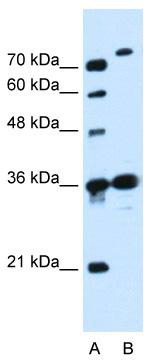SLC9A7 Rabbit Polyclonal Antibody
Other products for "SLC9A7"
Specifications
| Product Data | |
| Applications | WB |
| Recommended Dilution | WB |
| Reactivities | Human |
| Host | Rabbit |
| Isotype | IgG |
| Clonality | Polyclonal |
| Immunogen | The immunogen for Anti-SLC9A7 Antibody: synthetic peptide directed towards the N terminal of human SLC9A7. Synthetic peptide located within the following region: LGWGLRVAAAASASSSGAAAEDSSAMEELATEKEAEESHRQDSVSLLTFI |
| Formulation | Liquid. Purified antibody supplied in 1x PBS buffer with 0.09% (w/v) sodium azide and 2% sucrose. Note that this product is shipped as lyophilized powder to China customers. |
| Purification | Affinity Purified |
| Conjugation | Unconjugated |
| Storage | Store at -20°C as received. |
| Stability | Stable for 12 months from date of receipt. |
| Predicted Protein Size | 80 kDa |
| Gene Name | solute carrier family 9 member A7 |
| Database Link | |
| Background | Organelles of the secretory and endocytic pathways are distinguished by their luminal acidity, which is generated by the activity of an electrogenic vacuolar-type hydrogen ATPase. Progressive acidification of vesicles in the endocytic pathway is essential for the redistribution and degradation of internalized membrane proteins, such as ligand receptor complexes and fluid-phase solutes. It may play an important role in maintaining cation homeostasis and function of the trans-Golgi network.Organelles of the secretory and endocytic pathways are distinguished by their luminal acidity, which is generated by the activity of an electrogenic vacuolar-type hydrogen ATPase. Progressive acidification of vesicles in the endocytic pathway is essential for the redistribution and degradation of internalized membrane proteins, such as ligand receptor complexes and fluid-phase solutes. This gene is expressed predominantly in the trans-Golgi network, and mediates the influx of sodium or potassium in exchange for hydrogen. It may thus play an important role in maintaining cation homeostasis and function of the trans-Golgi network. This gene is part of a gene cluster on chromosome Xp11.23.Organelles of the secretory and endocytic pathways are distinguished by their luminal acidity, which is generated by the activity of an electrogenic vacuolar-type hydrogen ATPase. Progressive acidification of vesicles in the endocytic pathway is essential for the redistribution and degradation of internalized membrane proteins, such as ligand receptor complexes and fluid-phase solutes. This gene is expressed predominantly in the trans-Golgi network, and mediates the influx of sodium or potassium in exchange for hydrogen. It may thus play an important role in maintaining cation homeostasis and function of the trans-Golgi network. This gene is part of a gene cluster on chromosome Xp11.23. |
| Synonyms | NHE-7; NHE7; SLC9A6 |
| Note | Immunogen sequence homology: Dog: 100%; Pig: 100%; Human: 100%; Mouse: 100%; Rabbit: 100%; Zebrafish: 100%; Guinea pig: 100%; Goat: 85% |
| Reference Data | |
| Protein Families | Druggable Genome, Transmembrane |
Documents
| Product Manuals |
| FAQs |
{0} Product Review(s)
0 Product Review(s)
Submit review
Be the first one to submit a review
Product Citations
*Delivery time may vary from web posted schedule. Occasional delays may occur due to unforeseen
complexities in the preparation of your product. International customers may expect an additional 1-2 weeks
in shipping.






























































































































































































































































 Germany
Germany
 Japan
Japan
 United Kingdom
United Kingdom
 China
China



